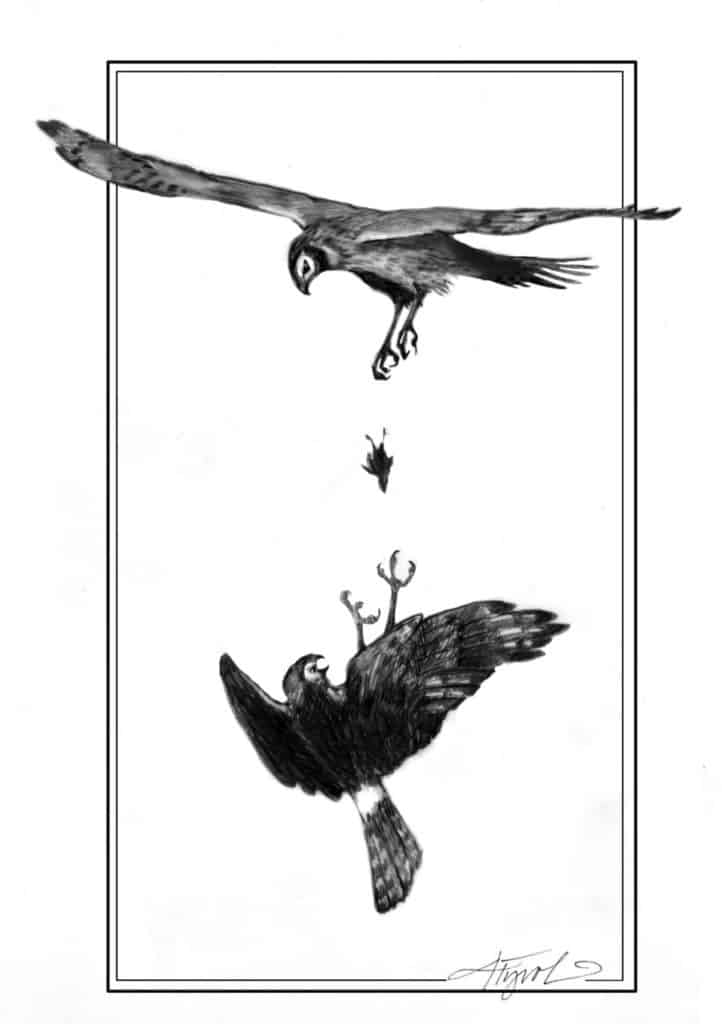
Erie was perched on a sunny branch when I met her on a cold day in March. She turned her head this way and that to survey her surroundings at the Vermont Institute of Natural Sciences (VINS). She is a slender hawk, brown above, with a dark-streaked, buff breast and a long, barred tail. A ring of light-colored feathers surrounds her face, giving her a facial disc similar to that of an owl.
Erie is a northern harrier and has lived at VINS for several years, since her wild ways were cut short by a serious injury. Unable to be returned to the wild, she has become an ambassador for her species, allowing visitors a rare chance for a close encounter with North America’s only harrier species.
The northern harrier is an unusual hawk in many ways. Its plumage is sexually dimorphic; the adult male is grey with light undersides, while the female is brown with buff-colored, streaked undersides. The obvious white rump patch of both sexes, visible during flight, can help distinguish northern harriers from other hawks, as can its location.
While other hawks are visual hunters, the northern harrier also relies on its sharp hearing to detect prey. Its facial disc of short, stiff feathers helps direct sound towards the bird’s ears. Once called a marsh hawk, the northern harrier hunts over agricultural land, marshes, and shrubby wetlands. Its slender shape and low, gliding flight are distinctive; while hunting, it has an almost floaty flight pattern, giving rise to the nickname “gray ghost.”
Once widespread in the Northeast’s suitable habitat, the northern harrier is now endangered or threatened in most of the region. This may be due in part to habitat loss as marshes were drained and areas once cleared for agricultural use revert to woodlands. Chris Martin, a raptor biologist with New Hampshire Audubon is working to determine the factors responsible for harriers’ decline in the region.
“At this point, it’s all a guessing game, not evidence based,” he said, noting a lack of comprehensive field surveys for a period of at least two decades. “We want to understand the decline. Is it due to habitat change? Increased predation on the ground?”
April is the start of a new field season for Martin and the colleagues he calls the “harrier hunters.” Male harriers typically begin returning from their wintering grounds in the southern U.S. and Central America in early April. Females arrive about a week later.
Last year, Martin’s team confirmed 10 breeding territories, mostly in the state’s northernmost Coos County. Six pairs were successful, fledging at least nine young. This summer, New Hampshire Audubon hopes to confirm more nests and add to their data on breeding success.
“They are charismatic birds, and not all that easy to study,” said Katrina Fenton, a seasonal field biologist for New Hampshire Audubon. “It’s the least common of our native hawks, and, unlike raptors that build an obvious stick nest, the harrier nests on a mound of dirt and grass, often in a thicket of red osier dogwood.”
Watching from a distance, she obtains cross-bearings on activity hotspots, allowing her to pinpoint nests. During her countless hours of field research, Fenton has observed playful behavior among harriers, as well as the “sky dance” performed by the courting male. This courtship display involves steep ascents, dives, and barrel rolls.
Another characteristic northern harrier behavior is the aerial food exchange. While the female is incubating eggs and tending the young, the male hunts for voles, mice, toads, small birds, and other food. Nearing the nest, he alerts his mate, and she flies up to expertly catch the prey he drops.
“It’s incredible to watch,” Fenton said. “She flies up from some invisible spot on the ground and flips over backwards in mid-air to catch the animal. Once the chicks are big enough, the female hunts, too, and the chicks learn to do the food exchange. Usually, they’re not all that good at it, unless it’s a snake.”
If you don’t catch sight of a northern harrier during nesting season, you might see one in September as they begin their southward migration. Pack Monadnock Raptor Observatory in New Hampshire and Putney Mountain in Vermont are excellent vantage points. While most harriers overwinter south of New England, the birds may be found during winter months in the Champlain Valley and in coastal marshes in New Hampshire.
Laurie D. Morrissey is a writer who lives in Hopkinton, New Hampshire. Illustration by Adelaide Murphy Tyrol. The Outside Story is assigned and edited by Northern Woodlands magazine and sponsored by the Wellborn Ecology Fund of the New Hampshire Charitable Foundation: nhcf.org.




